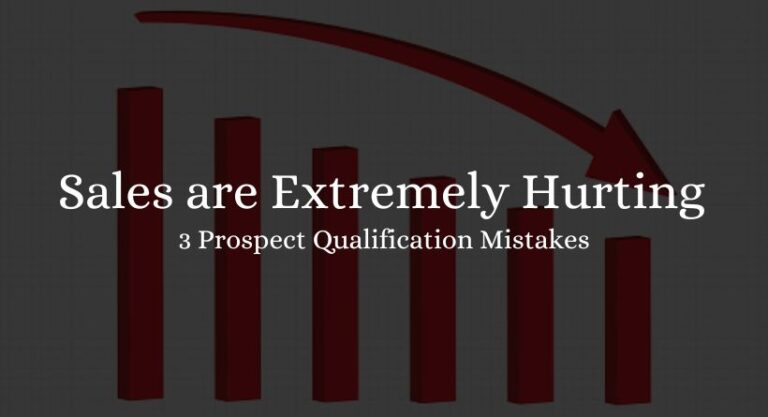Are you struggling to close deals and meet your sales targets? It’s time to take a closer look at your prospect qualification process. Identifying and nurturing high-quality leads is the cornerstone of a successful sales strategy. However, many businesses unknowingly make critical mistakes that hinder their sales efforts and impede growth.
In this comprehensive guide, we will delve into the four prospect qualification mistakes that may be hurting your sales. By understanding these common pitfalls and learning how to overcome them, you can revolutionize your approach to prospect qualification and drive more conversions.
But first, let’s acknowledge the problem. In a highly competitive marketplace, sales teams often face challenges when it comes to identifying and prioritizing the most promising prospects. Without an effective qualification process, valuable time and resources can be wasted on leads that are unlikely to convert. This can result in missed opportunities, low conversion rates, and ultimately, a negative impact on your bottom line.
Don’t fret, though. We’re here to provide you with the solutions you need to turn things around. We will walk you through a comprehensive overview of each prospect qualification mistake and offer actionable strategies to rectify them. By implementing these solutions, you will be able to optimize your sales process, focus on high-potential leads, and increase your chances of closing more deals.
Are you ready to uncover the prospect qualification mistakes that may be sabotaging your sales success? Let’s dive in!
Mistake #1: Failing to Define Ideal Customer Profiles
To effectively drive sales, it is crucial to have a clear understanding of your ideal customer profiles. Identifying and defining these profiles allows you to focus your efforts on the prospects most likely to convert into valuable customers. Yet, many businesses make the mistake of overlooking this vital step.
Without well-defined customer personas, your sales team may waste valuable time and resources pursuing leads that are unlikely to result in meaningful sales. Imagine casting a wide net and hoping to catch the right fish. Instead, by honing in on your ideal customer profiles, you can strategically target your efforts and tailor your messaging to resonate with the right audience.
So, how can you develop accurate and detailed ideal customer profiles? Start by analyzing your existing customer base. Look for patterns and common characteristics among your most loyal and profitable customers. Consider factors such as demographics, psychographics, buying behavior, pain points, and goals.
Additionally, conduct market research and gather insights about your target audience. Utilize surveys, interviews, and social listening tools to gain a deep understanding of their needs, preferences, and challenges. The more information you gather, the more precise and effective your ideal customer profiles will be.
By investing time and effort into defining your ideal customer profiles, you lay the foundation for successful sales. Armed with this knowledge, you can tailor your sales approach, craft compelling messaging, and address your prospects’ pain points directly. Remember, the key to unlocking higher sales lies in focusing your efforts on those who are most likely to become loyal and satisfied customers.
Mistake #2: Neglecting to Ask the Right Questions

When engaging with prospects, asking the right questions is paramount. These targeted and probing questions not only help you uncover valuable insights but also demonstrate your expertise and understanding of their specific needs. Unfortunately, many sales professionals fail to ask the right questions, hindering their ability to qualify prospects effectively.
- Consider this scenario: a prospect expresses interest in your product, and you immediately launch into a sales pitch without diving deeper into their motivations, challenges, and goals. By neglecting to ask relevant questions, you risk missing crucial information that could influence their purchasing decision.
To avoid this pitfall, adopt a consultative approach. Begin by asking open-ended questions that encourage prospects to share their pain points and desired outcomes. For example, instead of asking, “Are you satisfied with your current solution?” ask, “What are the biggest challenges you face with your current solution, and how do you envision overcoming them?”
Furthermore, don’t be afraid to ask follow-up questions to delve deeper into their responses. By actively listening and asking insightful questions, you gain a comprehensive understanding of their needs and can position your product or service as the ideal solution.
Remember, effective questioning is a powerful tool for uncovering prospects’ pain points, building rapport, and establishing yourself as a trusted advisor. So, be curious, be attentive, and ask the right questions that guide your sales conversations toward success.
Mistake #3: Overlooking Red Flags and Warning Signs
In the pursuit of closing deals, it’s tempting to ignore red flags and warning signs during the qualification process. However, doing so can lead to wasted time, effort, and resources on prospects who are unlikely to convert into paying customers. It’s crucial to recognize and address these indicators early on to ensure a more efficient sales process.
Red flags can come in various forms. They might include prospects who frequently miss scheduled calls, express hesitancy or lack of commitment, or continuously raise objections without offering potential solutions. Ignoring these signs and persisting with prospects who display such behaviors can result in a lengthy and unproductive sales cycle.
One common red flag is when a prospect fails to align with your ideal customer profiles. If their needs, budget, or industry don’t match your target market, it may be best to redirect your focus and resources elsewhere. Remember, it’s not about simply closing any deal; it’s about closing the right deals.
To avoid overlooking red flags, establish clear criteria for your ideal customers and consistently evaluate prospects against those criteria. Develop a system for recognizing warning signs early in the sales process and establish protocols for addressing them. This proactive approach will save you time, energy, and resources, allowing you to invest them where they are more likely to yield positive results.
By acknowledging and addressing red flags and warning signs promptly, you can streamline your sales process, focus on high-potential prospects, and increase your chances of closing deals that are mutually beneficial and sustainable. So, keep your eyes open, trust your instincts, and don’t overlook the signs that could be costing you valuable sales opportunities.
May Also Like Reading: What Is Soft Selling? Definition & Effective Salesperson’s Guide 2023
Conclusion
In conclusion, prospect qualification is the backbone of successful sales. By avoiding common mistakes and implementing effective strategies, you can significantly enhance your chances of closing deals and driving business growth. Throughout this blog post, we have explored the importance of defining ideal customer profiles, asking the right questions, recognizing red flags, and aligning with prospect needs and goals.
Remember, identifying and defining your ideal customer profiles allows you to focus your efforts on those who are most likely to convert into valuable customers. Asking targeted and probing questions uncovers valuable insights and positions you as a trusted advisor. Recognizing red flags early on saves you time and resources, enabling you to prioritize high-potential prospects. Lastly, aligning with prospect needs and goals ensures that your offerings resonate and address their specific requirements.
By implementing these strategies, you can optimize your sales process and unlock greater sales success. Take the time to develop accurate customer personas, hone your questioning techniques, and remain vigilant for red flags. Continuously align your sales approach with prospect needs, and tailor your offerings to meet their goals. Remember, every interaction is an opportunity to build relationships and drive meaningful sales.
Now, armed with the knowledge and insights from this blog post, it’s time to put these strategies into action. Review your current approach, identify areas for improvement, and take the necessary steps to refine and optimize your prospect qualification process. By doing so, you will position yourself for greater sales success and achieve your business goals.
Frequently Asked Questions
Q1: Why is defining ideal customer profiles important for sales success?
A1: Defining ideal customer profiles allows you to focus your efforts on prospects most likely to convert into valuable customers. It helps tailor your messaging, target the right audience, and optimize your sales process for better results.
Q2: How can asking the right questions improve prospect qualification?
A2: Asking targeted and probing questions helps uncover valuable insights, understand prospect needs and pain points, and position yourself as a trusted advisor. It enables you to tailor your approach and offer solutions that address their specific requirements.
Q3: What are common red flags during the qualification process?
A3: Common red flags include prospects showing hesitancy or lack of commitment, frequent missed calls or lack of responsiveness, and raising consistent objections without offering potential solutions. Recognizing these warning signs is crucial to avoid wasting time and effort on unqualified prospects.
Q4: How can I align with prospect needs and goals effectively?
A4: To align with prospect needs and goals, you must understand their motivations and challenges. Tailor your sales approach to address their specific requirements and offer solutions that resonate with their goals. This helps build trust and positions you as a valuable partner.







